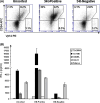CD34-based enrichment of genetically engineered human T cells for clinical use results in dramatically enhanced tumor targeting
- PMID: 20052466
- PMCID: PMC3736983
- DOI: 10.1007/s00262-009-0810-8
CD34-based enrichment of genetically engineered human T cells for clinical use results in dramatically enhanced tumor targeting
Abstract
Objective clinical responses can be achieved in melanoma patients by infusion of T cell receptor (TCR) gene transduced T cells. Although promising, the therapy is still largely ineffective, as most patients did not benefit from treatment. That only a minority of the infused T cells were genetically modified and that these were extensively expanded ex vivo may have prevented their efficacy. We developed novel and generally applicable retroviral vectors that allow rapid and efficient selection of T cells transduced with human TCRs. These vectors encode two TCR chains and a truncated CD34 molecule (CD34t) in a single mRNA transcript. Transduced T cells were characterized and the effects of CD34-based enrichment of redirected T cells were evaluated. Both CD8(+) and CD4(+) T cells could be transduced and efficiently co-expressed all introduced transgenes on their surface. Importantly, more than fivefold enrichment of both the frequency of transduced cells and the specific anti-tumor reactivity of the effector population could be achieved by magnetic beads-based enrichment procedures readily available for clinical grade hematopoietic stem cell isolation. This CD34-based enrichment technology will improve the feasibility of adoptive transfer of clinically relevant effectors. In addition to their enhanced tumor recognition, the enriched redirected T cells may also show superior reactivity and persistence in vivo due to the high purity of transduced cells and the shortened ex vivo culture.
Figures





Similar articles
-
Simultaneous generation of CD8+ and CD4+ melanoma-reactive T cells by retroviral-mediated transfer of a single T-cell receptor.Cancer Res. 2005 Feb 15;65(4):1570-6. doi: 10.1158/0008-5472.CAN-04-2076. Cancer Res. 2005. PMID: 15735047
-
High efficiency TCR gene transfer into primary human lymphocytes affords avid recognition of melanoma tumor antigen glycoprotein 100 and does not alter the recognition of autologous melanoma antigens.J Immunol. 2003 Sep 15;171(6):3287-95. doi: 10.4049/jimmunol.171.6.3287. J Immunol. 2003. PMID: 12960359 Free PMC article.
-
RNA-transfection of γ/δ T cells with a chimeric antigen receptor or an α/β T-cell receptor: a safer alternative to genetically engineered α/β T cells for the immunotherapy of melanoma.BMC Cancer. 2017 Aug 17;17(1):551. doi: 10.1186/s12885-017-3539-3. BMC Cancer. 2017. PMID: 28818060 Free PMC article.
-
Genetic engineering of T cells for adoptive immunotherapy.Immunol Res. 2008;42(1-3):166-81. doi: 10.1007/s12026-008-8057-6. Immunol Res. 2008. PMID: 18841331 Free PMC article. Review.
-
Potential use of T cell receptor genes to modify hematopoietic stem cells for the gene therapy of cancer.Pathol Oncol Res. 1999;5(1):3-15. doi: 10.1053/paor.1999.0003. Pathol Oncol Res. 1999. PMID: 10079371 Review.
Cited by
-
Adoptive immunotherapy of cancer: Gene transfer of T cell specificity.Self Nonself. 2011 Apr;2(2):80-84. doi: 10.4161/self.2.2.15832. Epub 2011 Apr 1. Self Nonself. 2011. PMID: 22299059 Free PMC article.
-
Blocking TCR restimulation induced necroptosis in adoptively transferred T cells improves tumor control.Oncotarget. 2016 Oct 25;7(43):69371-69383. doi: 10.18632/oncotarget.12674. Oncotarget. 2016. PMID: 27750220 Free PMC article.
-
HDAC inhibition prevents transgene expression downregulation and loss-of-function in T-cell-receptor-transduced T cells.Mol Ther Oncolytics. 2021 Jan 26;20:352-363. doi: 10.1016/j.omto.2021.01.014. eCollection 2021 Mar 26. Mol Ther Oncolytics. 2021. PMID: 33614916 Free PMC article.
-
Rationally Designed Transgene-Encoded Cell-Surface Polypeptide Tag for Multiplexed Programming of CAR T-cell Synthetic Outputs.Cancer Immunol Res. 2021 Sep;9(9):1047-1060. doi: 10.1158/2326-6066.CIR-20-0470. Epub 2021 Jul 9. Cancer Immunol Res. 2021. PMID: 34244298 Free PMC article.
-
The split nature of tumor-infiltrating leukocytes: Implications for cancer surveillance and immunotherapy.Oncoimmunology. 2012 Aug 1;1(5):717-725. doi: 10.4161/onci.20068. Oncoimmunology. 2012. PMID: 22934263 Free PMC article.
References
-
- Dudley ME, Yang JC, Sherry R, Hughes MS, Royal R, Kammula U, Robbins PF, Huang J, Citrin DE, Leitman SF, Wunderlich J, Restifo NP, Thomasian A, Downey SG, Smith FO, Klapper J, Morton K, Laurencot C, White DE, Rosenberg SA. Adoptive cell therapy for patients with metastatic melanoma: evaluation of intensive myeloablative chemoradiation preparative regimens. J Clin Oncol. 2008;26:5233–5239. doi: 10.1200/JCO.2008.16.5449. - DOI - PMC - PubMed
-
- Clay TM, Custer MC, Sachs J, Hwu P, Rosenberg SA, Nishimura MI. Efficient transfer of a tumor antigen-reactive TCR to human peripheral blood lymphocytes confers anti-tumor reactivity. J Immunol. 1999;163:507–513. - PubMed
Publication types
MeSH terms
Substances
Grants and funding
LinkOut - more resources
Full Text Sources
Other Literature Sources
Medical
Research Materials

